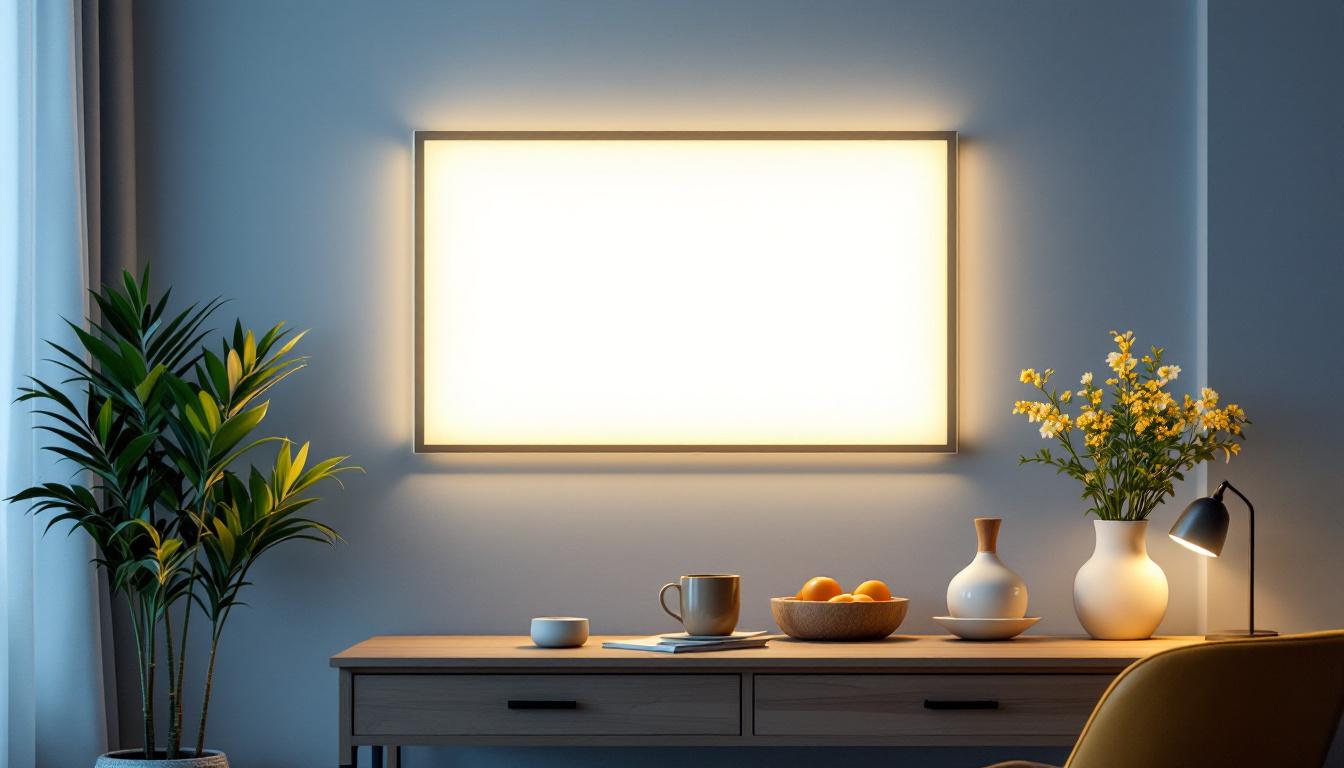
In the evolving world of lighting design, LED flat panel light fixtures have emerged as a game-changer for contractors and designers alike. These fixtures offer a sleek, modern aesthetic combined with superior functionality, making them an ideal choice for a wide range of commercial and residential applications. Understanding their benefits and technical attributes is essential for lighting contractors aiming to deliver high-quality, energy-efficient lighting solutions.
LED flat panel lights are characterized by their thin, lightweight design and uniform light distribution. Unlike traditional fluorescent troffers or bulky fixtures, flat panels provide a clean, minimalist look that seamlessly integrates into ceilings without compromising on illumination quality. This makes them particularly attractive for office spaces, healthcare facilities, educational institutions, and retail environments where both appearance and performance are paramount.
One of the standout features of LED flat panel lights is their energy efficiency. Consuming significantly less power than conventional lighting options, these fixtures can lead to substantial savings on electricity bills over time. Additionally, they have a longer lifespan, often exceeding 50,000 hours, which reduces the frequency and costs associated with replacements. This longevity not only benefits the bottom line but also contributes to a more sustainable approach to lighting, aligning with the growing emphasis on eco-friendly practices in various industries.
Moreover, LED flat panel lights are available in a variety of color temperatures and dimming options, allowing for customizable lighting solutions tailored to specific environments and tasks. For instance, a cooler light may be preferred in workspaces to enhance focus and productivity, while warmer tones can create a more inviting atmosphere in retail settings or restaurants. The versatility of these fixtures also extends to their installation; they can be recessed, surface-mounted, or suspended, making them adaptable to diverse architectural styles and ceiling types. This flexibility further solidifies their position as a preferred choice among designers and contractors aiming to create functional yet aesthetically pleasing spaces.
One of the most compelling reasons to choose LED flat panel fixtures is their exceptional energy efficiency. These lights consume significantly less power compared to traditional fluorescent or incandescent alternatives, often reducing energy consumption by up to 50-70%. For lighting contractors, this translates into a strong selling point when advising clients on long-term operational savings. The reduced energy demand not only lowers utility bills but also contributes to a smaller carbon footprint, aligning with the growing emphasis on sustainability in building design.
Moreover, the long lifespan of LED panels—often exceeding 50,000 hours—means fewer replacements and maintenance costs. This durability is particularly advantageous in commercial settings where fixture replacement can disrupt business operations and incur additional labor expenses. In addition, many LED flat panels come with warranties that extend up to five years, providing peace of mind for both contractors and end-users. This combination of longevity and reliability can significantly enhance the overall return on investment, making LED technology a financially sound choice for any lighting project.
LED flat panels provide consistent, glare-free illumination that enhances visual comfort. Their design ensures even light distribution across the entire panel surface, eliminating the patchy lighting and shadows commonly associated with older lighting technologies. This quality of light is critical in environments such as offices, where reducing eye strain can improve productivity and employee well-being. Furthermore, the flicker-free operation of LED lights minimizes distractions and enhances focus, making them ideal for environments that require prolonged concentration.
Additionally, these fixtures offer excellent color rendering capabilities, often with a Color Rendering Index (CRI) of 80 or higher. This means colors appear more natural and vibrant, which is essential in retail spaces and healthcare facilities where accurate color perception can impact customer experience and clinical outcomes. The ability to select different color temperatures allows designers to create atmospheres that can energize a space or provide a calming effect, catering to the specific needs of various applications, from bustling retail floors to serene waiting rooms.
The slim profile and variety of sizes available for LED flat panel lights provide lighting contractors with unparalleled design flexibility. They can be recessed into ceilings, surface-mounted, or suspended, allowing for creative lighting layouts that complement architectural features rather than detract from them. This versatility is particularly beneficial in modern architectural designs where sleek lines and minimalistic aesthetics are favored, enabling seamless integration of lighting into the overall design scheme.
Furthermore, the ability to choose from different color temperatures—from warm white to daylight—enables tailored lighting schemes that suit the mood and function of each space. This adaptability makes LED flat panels a versatile choice for diverse projects, from cozy hospitality venues to bright, focused workspaces. Additionally, some models come equipped with smart technology, allowing for dimming and color-changing capabilities that can be controlled via mobile apps or smart home systems. This innovation not only enhances user experience but also allows for dynamic lighting adjustments that can transform a space for different activities or times of day, further expanding the creative possibilities for designers and architects alike.
When specifying LED flat panel fixtures, it’s crucial to consider lumen output relative to wattage. Lumens measure the amount of light emitted, while wattage indicates energy consumption. A high lumen-to-watt ratio is desirable because it means more light is produced for less energy.
For example, a 40-watt LED flat panel can deliver the same or greater brightness than a 75-watt fluorescent fixture. This efficiency allows contractors to meet lighting standards and client expectations while minimizing energy costs.
Color temperature, measured in Kelvins (K), significantly influences the ambiance and functionality of a space. Cooler temperatures (4000K to 5000K) produce a crisp, bright light ideal for work environments, while warmer temperatures (2700K to 3000K) create a relaxing atmosphere suited for hospitality or residential settings.
Lighting contractors should work closely with clients to select the appropriate color temperature that aligns with the intended use of the space, enhancing both comfort and productivity.
Modern LED flat panel fixtures often support dimming and can be integrated with advanced lighting control systems. This capability allows for dynamic lighting scenes, energy savings through occupancy sensors, and compliance with building codes focused on sustainability.
Contractors should ensure compatibility between the LED drivers and control systems to avoid flickering or reduced lifespan. Proper integration can elevate the lighting design, providing clients with customizable and energy-efficient solutions.
Successful installation begins with a thorough site assessment. Lighting contractors should evaluate existing ceiling types, electrical infrastructure, and spatial requirements to determine the most suitable mounting method for the LED flat panels.
Ensuring that the power supply matches the fixture specifications and that there is adequate clearance for ventilation will help prevent premature fixture failure and maintain optimal performance.
LED flat panels offer multiple installation options:
Choosing the correct mounting style depends on the architectural context and client preferences. Each method requires specific hardware and installation techniques to ensure safety and durability.
Proper wiring is essential for both fixture performance and safety compliance. Contractors should follow local electrical codes and manufacturer guidelines to ensure correct voltage and grounding. Using high-quality connectors and avoiding overloading circuits will reduce the risk of electrical faults.
Additionally, LED flat panels generate minimal heat, but adequate ventilation should still be maintained to prolong fixture life. Ensuring that fixtures are securely mounted and protected from moisture or dust ingress is also critical, especially in environments like kitchens or healthcare facilities.
A mid-sized corporate office recently upgraded its lighting system by replacing outdated fluorescent troffers with LED flat panel fixtures. The retrofit resulted in a 60% reduction in energy consumption and a noticeable improvement in light quality. Employees reported less eye strain and greater comfort, contributing to higher productivity levels.
The slim design of the panels allowed for a clean ceiling appearance, complementing the modern interior design. Additionally, the integration of dimmable controls enabled the facility manager to adjust lighting levels based on natural daylight availability, further optimizing energy use.
In a healthcare setting, lighting plays a crucial role in patient recovery and staff efficiency. An outpatient clinic installed LED flat panel lights with a high CRI and adjustable color temperature. This allowed for bright, clear lighting during clinical procedures and softer, warmer lighting in waiting areas to promote relaxation.
The uniform illumination reduced shadows and glare, enhancing visibility for medical staff and creating a welcoming environment for patients. The long lifespan and low maintenance requirements of the LED panels also minimized disruptions and operational costs.
The future of LED flat panel fixtures is closely tied to smart building technologies. Integration with IoT-enabled sensors and controls will allow lighting systems to respond dynamically to occupancy, daylight, and user preferences. This not only enhances energy efficiency but also creates personalized lighting environments that improve occupant well-being.
Ongoing innovations in materials science are leading to even thinner, lighter, and more durable LED panels. Enhanced diffuser technologies improve light uniformity and reduce glare further, while modular designs allow for easier customization and scalability in large projects.
Environmental considerations are increasingly influencing lighting design. LED flat panel manufacturers are adopting sustainable materials and designing products for easier recycling and reuse. Lighting contractors can support these initiatives by selecting fixtures with certifications that emphasize environmental responsibility.
LED flat panel light fixtures represent a significant advancement in lighting technology, offering lighting contractors a powerful tool to create better lighting designs. Their energy efficiency, superior light quality, aesthetic versatility, and long-term cost savings make them an excellent choice for a variety of applications.
By understanding the technical aspects, installation best practices, and emerging trends, contractors can confidently recommend and implement LED flat panel solutions that meet client needs and contribute to sustainable, high-performance lighting environments.
Ready to elevate your lighting designs with the cutting-edge efficiency and style of LED flat panel light fixtures? At LumenWholesale, we provide lighting contractors with the highest quality, spec-grade lighting products at unparalleled wholesale prices. Say goodbye to inflated costs from local distributors and hello to our extensive selection that meets rigorous industry standards. With LumenWholesale, bulk buying is a breeze, complete with free shipping and no hidden fees. Don’t compromise on quality or value—choose LumenWholesale for your lighting needs and enjoy the perfect fusion of affordability and convenience. Wholesale Lighting at the Best Value is just a click away.

Discover the essential insights and expert tips in our ultimate guide to commercial LED lighting for contractors.

Discover effective strategies for training your team in the latest grow LED lighting technologies.

Discover the essential insights on under cabinet lighting fixtures from expert lighting contractors.

Discover effective strategies for training your team in the installation and maintenance of outdoor halogen lighting.